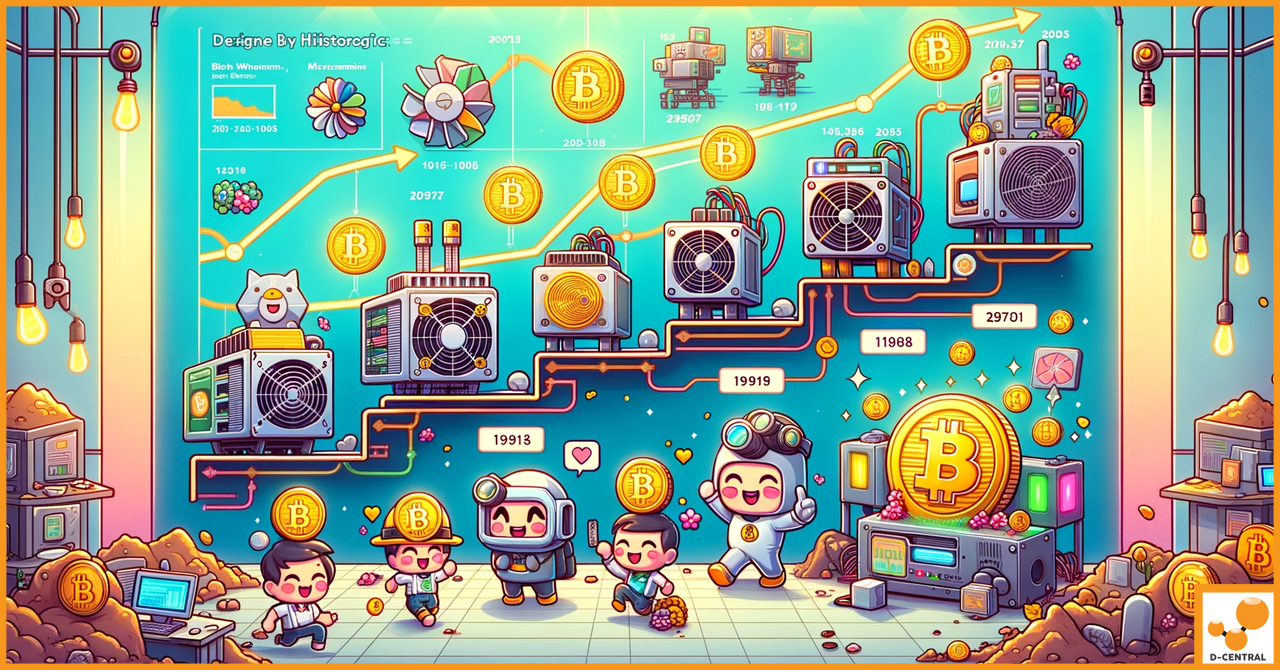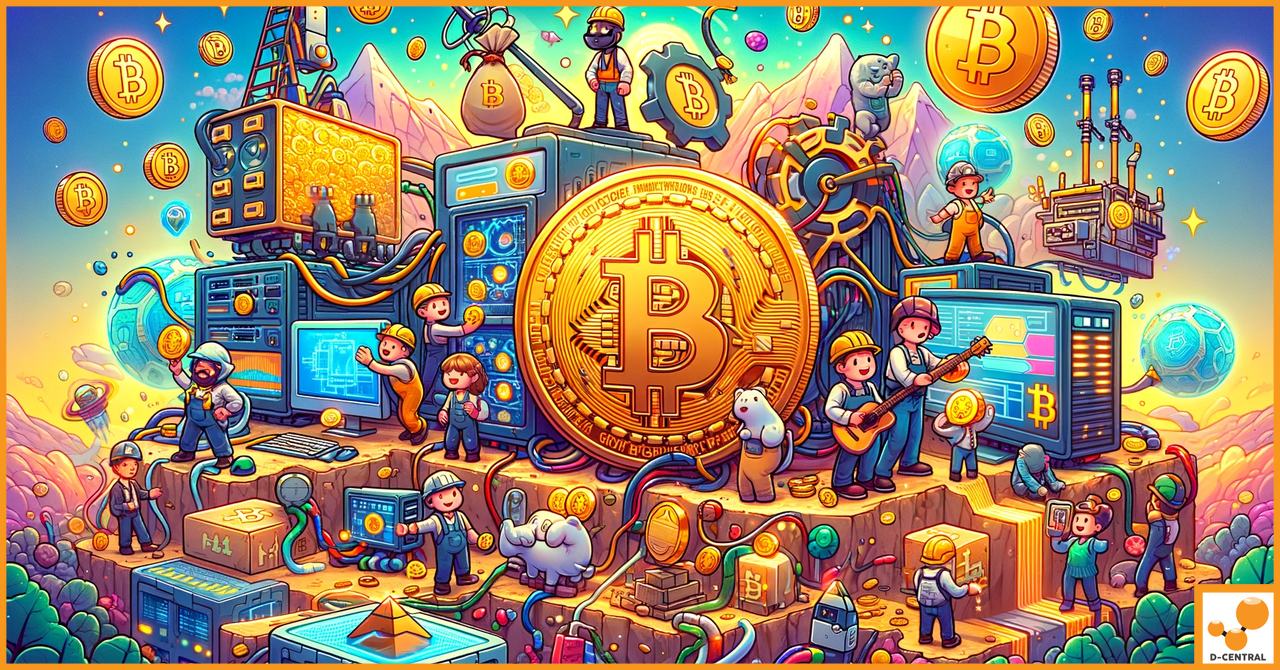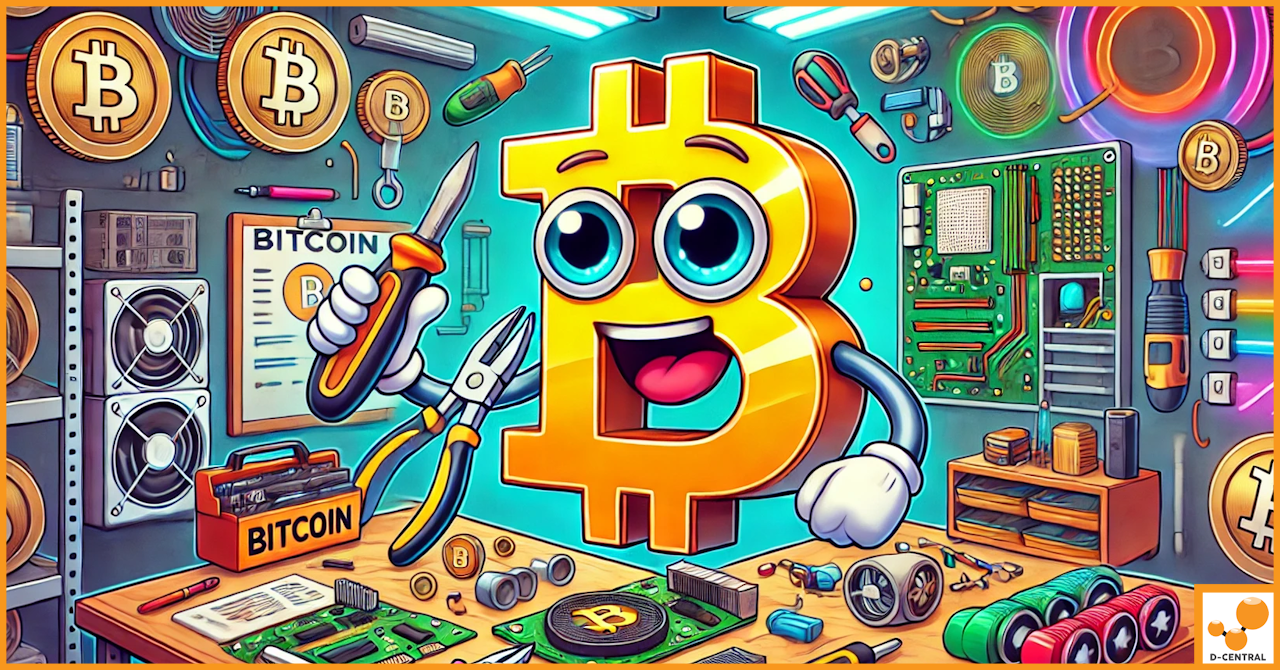
How MicroBT Whatsminer Has Evolved Over the Years: A Comprehensive Look
In the dynamic world of cryptocurrency mining, the quest for more efficient, powerful, and cost-effective mining hardware is perpetual. At
4479 Desserte Nord Autoroute 440, Laval, QC H7P 6E2

Bitcoin, the pioneering cryptocurrency, has captivated the world’s attention since its inception in 2009. At the heart of Bitcoin’s decentralized nature lies a process known as Bitcoin mining, a cornerstone of the cryptocurrency ecosystem. This intricate process not only facilitates the creation of new bitcoins but also plays a crucial role in maintaining and securing the blockchain, the ledger that records all Bitcoin transactions.
Mining involves the use of sophisticated hardware and software to solve complex mathematical problems. When these problems are solved, a new block of transactions is added to the blockchain, and the successful miner is rewarded with a set number of bitcoins. This reward, an incentive for miners to support the network, is pivotal to the functioning and security of the Bitcoin ecosystem.
However, Bitcoin mining is not just about the creation of new coins. It is a competitive and dynamic field, influenced by various factors including technological advancements, market dynamics, and changes in network difficulty. The reward system itself has undergone significant changes over the years, adapting to the evolving landscape of the cryptocurrency world.
The purpose of this article is to provide a detailed and comprehensive understanding of Bitcoin mining rewards. We aim to demystify the complexities surrounding these rewards, exploring how they are calculated, distributed, and how they have evolved over time. Whether you are a seasoned miner, a cryptocurrency enthusiast, or simply curious about the inner workings of Bitcoin, this guide will offer valuable insights into one of the most critical aspects of the cryptocurrency world – the mining rewards.
Bitcoin mining is the process by which new bitcoins are introduced into circulation and is also a critical component of the maintenance and development of the blockchain ledger. It is performed using very sophisticated computers that solve extremely complex computational math problems. Mining is not just about creating new bitcoins; it’s about validating transactions and ensuring the Bitcoin network’s integrity and chronological order.
At its core, mining involves miners competing to solve a cryptographic puzzle, and the first one to solve it gets the chance to add a new block of transactions to the blockchain. In return for their efforts and the resources expended (like electricity and computing power), miners are rewarded with new bitcoins. This process is known as the block reward.
Miners play a crucial role in the Bitcoin ecosystem. They are not just creators of new bitcoins but are also the system’s auditors. They perform the critical task of ensuring the legitimacy of Bitcoin transactions. This importance of this role stems from Bitcoin’s decentralized nature, which means there isn’t a central authority to validate transactions. Instead, miners prevent double-spending, a scenario where a Bitcoin owner illicitly spends the same bitcoin twice.
The mining process involves compiling recent transactions into blocks and trying to solve a computationally difficult puzzle. The participant who first solves the puzzle gets to place the next block on the blockchain and claim the rewards. These rewards, which incentivize mining, are both the transaction fees associated with the transactions compiled in the block as well as newly released bitcoin.
The blockchain is a distributed ledger, a decentralized database that is shared among the nodes of a computer network. It stores information electronically in digital format and is known for its crucial role in cryptocurrency systems, particularly Bitcoin, for maintaining a secure and decentralized record of transactions. The innovation of the blockchain is that it guarantees the fidelity and security of a record of data and generates trust without the need for a trusted third party.
One of the key concepts in blockchain technology is ‘proof of work’. Proof of work is a consensus algorithm used by Bitcoin and other cryptocurrencies to confirm transactions and produce new blocks to the chain. With proof of work, miners compete to solve a difficult mathematical problem based on the hash algorithm. The first miner to solve the problem gets to add new blocks to the blockchain. This process not only validates transactions and secures the network but also ensures that all participants in the network have a synchronized view of the data.
In summary, Bitcoin mining is a fundamental process that underpins the existence and functionality of the Bitcoin network. It involves solving complex computational problems to validate transactions and secure the network, with successful miners being rewarded with new bitcoins and transaction fees. The blockchain and proof of work are central to this process, ensuring security, trust, and integrity in the decentralized ecosystem of Bitcoin.
In the realm of Bitcoin, mining rewards refer to the incentives given to miners for their role in validating transactions and adding new blocks to the blockchain. These rewards serve two primary purposes: they provide miners with compensation for their computational efforts and electricity costs, and they introduce new bitcoins into circulation, a process crucial to Bitcoin’s design as a deflationary currency.
Mining rewards consist of two components: the block reward and transaction fees. The block reward is a set amount of bitcoins awarded to the miner who successfully adds a new block to the blockchain. This reward is halved approximately every four years in an event known as the Bitcoin halving. The second component, transaction fees, is the sum of fees that users pay to have their transactions included in a block. As the block reward diminishes over time, these transaction fees are designed to become a more significant part of the reward, ensuring continued incentive for mining activities.
The evolution of mining rewards is a fascinating aspect of Bitcoin’s history. When Bitcoin was first introduced in 2009, the block reward was 50 bitcoins. This reward remained in place until November 2012, when the first halving occurred, reducing the block reward to 25 bitcoins. Subsequent halvings in 2016 and 2020 further reduced the reward to 12.5 and then to 6.25 bitcoins, respectively.
These halving events are a critical part of Bitcoin’s monetary policy, embedded in its code by Satoshi Nakamoto, the pseudonymous creator of Bitcoin. The halving events are scheduled to occur every 210,000 blocks, or approximately every four years, until the maximum supply of 21 million bitcoins has been reached. This diminishing reward system was designed to mimic the extraction of precious resources like gold, a process that becomes progressively more difficult and less rewarding over time.
Mining rewards are the linchpin of the Bitcoin network, serving as the primary incentive for miners to contribute their computational power. This incentive is crucial for the security and functionality of the blockchain. The more miners participate, the more decentralized and secure the network becomes, making it resistant to attacks and fraud.
For miners, these rewards represent the return on investment for their computational resources and electricity costs. As the difficulty of mining increases and the rewards decrease over time, miners are motivated to seek more efficient mining technologies and practices. This drive for efficiency fosters innovation in the mining industry, leading to the development of advanced mining hardware like ASICs (Application-Specific Integrated Circuits).
Moreover, mining rewards play a significant role in the Bitcoin economy. They influence the supply of new bitcoins in the market, impacting Bitcoin’s price and scarcity. As the rate of new bitcoins entering the market slows down due to halvings, the scarcity of Bitcoin increases, which can have implications for its value.
Mining rewards are not just a mechanism for compensating miners; they are a fundamental aspect of Bitcoin’s design, influencing its security, economic model, and long-term viability. Understanding these rewards and their evolution is essential for anyone involved in or interested in the Bitcoin ecosystem.
Mining rewards in Bitcoin are calculated based on a combination of factors: the block reward and transaction fees. The total reward a miner receives is the sum of these two components.
The total mining reward for a block is the sum of the block reward and the transaction fees for all transactions included in that block. As the block reward continues to halve over time, the proportion of transaction fees in the total reward is expected to increase.
The creation of new bitcoins is an integral part of the mining process, often referred to as the “coinbase” transaction. This is the first transaction in each new block and is created by the successful miner. The coinbase transaction awards the miner with the block reward, effectively introducing new bitcoins into circulation.
This process is governed by the Bitcoin protocol, which dictates the rate at which new bitcoins are created and the maximum number of bitcoins that will ever exist – capped at 21 million. The halving events reduce the rate of new bitcoin creation, ensuring that the final bitcoin will not be mined until around the year 2140.
Through mining, Bitcoin not only ensures the ongoing creation of new coins but also maintains the network’s security and integrity. The combination of block rewards and transaction fees incentivizes miners to contribute their computational power, validating transactions, and maintaining the blockchain. This elegant system of rewards underpins the functionality and value of Bitcoin, balancing the creation of new coins with the demand for transaction processing and network security.
Bitcoin halving is a significant event in the cryptocurrency world, occurring approximately every four years. It is a feature written into Bitcoin’s code by its creator, Satoshi Nakamoto, to control the rate at which new bitcoins are generated by the network. During a halving event, the reward for mining new blocks is halved, meaning miners receive 50% fewer bitcoins for verifying transactions.
The halving is designed to mimic the rate of diminishing returns in mining precious metals like gold. This process is a critical part of Bitcoin’s deflationary nature, ensuring that the total supply of bitcoins approaches the maximum limit of 21 million in a controlled and predictable manner. The halving continues until the maximum supply of bitcoins has been mined, which is expected to occur around the year 2140.
Since the inception of Bitcoin in 2009, there have been several halving events:
Historically, halving events have led to increased public interest in Bitcoin and have been followed by significant price increases. However, it’s important to note that these price movements are influenced by a multitude of factors, and the halving is just one of them.
The impact of future Bitcoin halvings is a subject of much speculation in the cryptocurrency community. Some of the anticipated implications include:
Bitcoin halvings are pivotal events that not only affect the miners’ rewards but also have broader implications for the Bitcoin ecosystem. They highlight the unique economic model of Bitcoin and play a crucial role in its long-term value proposition. As we approach future halvings, the anticipation and speculation surrounding these events are likely to continue, underscoring the dynamic and evolving nature of Bitcoin.
Mining pools are groups of cryptocurrency miners who combine their computational resources over a network to strengthen their chances of finding a block or mining a transaction. They share their processing power over the network to split the reward equally, according to the amount of work they contributed to the probability of finding a block. This approach offers individual miners a more predictable and steady income.
Mining pools are crucial for several reasons:
There are several types of mining pools, each with its own structure and method of reward distribution:
Each reward distribution method has its advantages and disadvantages, affecting miners’ earnings and behavior:
Mining pools play a vital role in the Bitcoin mining ecosystem by offering individual miners a more viable way to receive rewards. The choice of a mining pool and reward distribution method can significantly impact a miner’s earnings and should be made based on individual preferences, risk tolerance, and the miner’s long-term commitment to mining. As the Bitcoin network evolves, so too do the structures and strategies of mining pools, reflecting the dynamic nature of the cryptocurrency world.
Maximizing mining rewards requires a combination of efficient hardware and software, strategic decision-making, and careful selection of a mining pool. Staying informed and adaptable to the changing landscape of cryptocurrency mining is crucial for success in this competitive field
While Bitcoin mining can be a lucrative venture, it comes with its set of challenges and misconceptions. Understanding these aspects is crucial for anyone looking to enter the mining space. Miners must navigate a complex landscape that includes not only technical and economic considerations but also environmental and regulatory factors.
In this comprehensive exploration of Bitcoin mining, we have journeyed through the intricate and dynamic world that underpins one of the most revolutionary technologies of our time. From the foundational mechanics of mining to the nuanced strategies for maximizing rewards, this guide has aimed to demystify the complexities of Bitcoin mining and illuminate its critical role in the cryptocurrency ecosystem.
We began by understanding the basics of Bitcoin mining, unraveling how this digital process is integral to maintaining the blockchain’s integrity and facilitating the creation of new bitcoins. The role of miners, pivotal in validating transactions and securing the network, was also highlighted, along with an introduction to the concepts of blockchain and proof of work.
Delving into the mechanics of mining rewards, we examined how these incentives are calculated and distributed. The dual components of block rewards and transaction fees were discussed, shedding light on how they contribute to the overall profitability of mining activities. The significance of the Bitcoin halving event was also explored, revealing its profound impact on Bitcoin’s value and the mining landscape.
The discussion then shifted to mining pools and their reward distribution methods, offering insights into how miners can collaborate to achieve more predictable and steady returns. Various types of mining pools and their operational nuances were analyzed, providing a clearer understanding of how different reward structures can influence a miner’s earnings.
Addressing common misconceptions and challenges, we tackled some of the myths surrounding Bitcoin mining and confronted the realities of its energy consumption and environmental impact. The challenges faced by miners, including the increasing difficulty level, regulatory hurdles, and the volatility of Bitcoin’s market value, were also examined.
As we conclude, it’s evident that understanding Bitcoin mining rewards is not just crucial for potential miners but also for investors and enthusiasts seeking a deeper comprehension of the cryptocurrency world. The knowledge of how mining works, its rewards, and challenges provides a solid foundation for making informed decisions in this rapidly evolving domain.
What is Bitcoin mining?
Bitcoin mining is the process of using sophisticated hardware and software to solve complex mathematical problems. Successful mining adds a new block of transactions to the blockchain and rewards the miner with bitcoins.
What role do miners play in the Bitcoin network?
Miners validate transactions and secure the Bitcoin network by solving cryptographic puzzles to add new blocks to the blockchain. This decentralized auditing process prevents double-spending and maintains the network’s integrity.
What are Bitcoin mining rewards?
Mining rewards consist of newly created bitcoins and transaction fees. The rewards serve as an incentive for miners to maintain the network and act as a method for introducing new bitcoins into circulation.
What is a mining pool?
A mining pool is a group of miners who combine their computing power to increase their chances of mining a block and receiving rewards. The rewards are then distributed among the pool members based on their contribution.
How are mining rewards distributed?
Rewards are distributed based on the block reward, set to halve approximately every four years, and transaction fees attributed to transactions included in the mined block.
What is the Bitcoin halving event?
The Bitcoin halving event is when the block reward for mining a new block is halved. This occurs approximately every four years and is designed to control the rate of new bitcoins entering circulation and emulate the diminishing returns of mining precious resources.
How does halving impact Bitcoin’s value and mining rewards?
Historically, halvings have led to increased public interest and significant price increases for Bitcoin. However, they also reduce miners’ revenues from the block reward, making transaction fees more important for mining profitability.
What challenges do Bitcoin miners face?
Miners face challenges such as increasing difficulty levels, high energy consumption, regulatory changes, hardware costs and availability, market volatility, and network security risks, among others.
Can individual miners profitably mine Bitcoin from home?
Due to increased mining difficulty and the need for specialized equipment, it is challenging for individuals to profitably mine Bitcoin from home without significant investment and access to low-cost electricity.
What strategies can miners use to maximize their rewards?
Strategies include optimizing hardware efficiency, keeping energy costs low, updating mining software, maintaining equipment regularly, choosing a suitable mining pool, diversifying mining activities, and staying informed about market trends.
DISCLAIMER: D-Central Technologies and its associated content, including this blog, do not serve as financial advisors or official investment advisors. The insights and opinions shared here or by any guests featured in our content are provided purely for informational and educational purposes. Such communications should not be interpreted as financial, investment, legal, tax, or any form of specific advice. We are committed to advancing the knowledge and understanding of Bitcoin and its potential impact on society. However, we urge our community to proceed with caution and informed judgment in all related endeavors.
Related Posts

In the dynamic world of cryptocurrency mining, the quest for more efficient, powerful, and cost-effective mining hardware is perpetual. At

Welcome to the exciting world of DIY Bitcoin mining! In this comprehensive guide, we’ll walk you through the process of

In the rapidly evolving landscape of cryptocurrency, Bitcoin mining has emerged as a powerful force not just in the digital